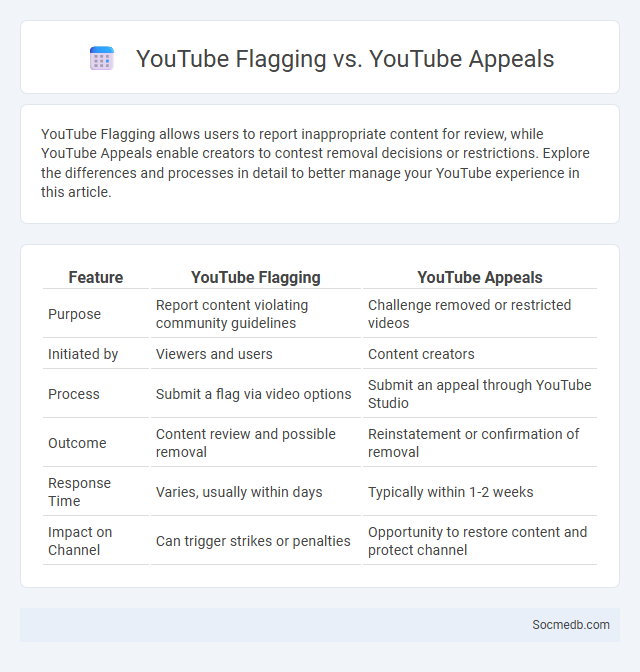
Photo illustration: YouTube Flagging vs YouTube Appeals
YouTube Flagging allows users to report inappropriate content for review, while YouTube Appeals enable creators to contest removal decisions or restrictions. Explore the differences and processes in detail to better manage your YouTube experience in this article.
Table of Comparison
| Feature | YouTube Flagging | YouTube Appeals |
|---|---|---|
| Purpose | Report content violating community guidelines | Challenge removed or restricted videos |
| Initiated by | Viewers and users | Content creators |
| Process | Submit a flag via video options | Submit an appeal through YouTube Studio |
| Outcome | Content review and possible removal | Reinstatement or confirmation of removal |
| Response Time | Varies, usually within days | Typically within 1-2 weeks |
| Impact on Channel | Can trigger strikes or penalties | Opportunity to restore content and protect channel |
Understanding YouTube Flagging: What It Means
YouTube flagging is a system where users report content that may violate community guidelines related to hate speech, harassment, or misinformation. Once a video is flagged, it undergoes review by YouTube's moderation team to determine if it requires removal, age restriction, or demonetization. Understanding this process helps creators navigate content policies and maintain compliance to avoid penalties or channel suspension.
Common Reasons for YouTube Flagging
YouTube flags content primarily for violations of its Community Guidelines, including hate speech, harassment, and harmful or dangerous content. Copyright infringement and misleading metadata such as clickbait titles or thumbnails are also common reasons for flagging. Ensuring your videos comply with YouTube's policies helps protect your channel from removal or demonetization.
How the YouTube Flagging Process Works
YouTube's flagging process enables users to report videos that violate community guidelines, such as those containing hate speech, violence, or copyright infringement. When you flag a video, the content is reviewed by YouTube's team to determine if it breaches policies, potentially leading to removal or restrictions. This system helps maintain a safe platform by empowering your voice in identifying inappropriate or harmful content.
What Happens After a Video Is Flagged on YouTube
After a video is flagged on YouTube, the platform's automated systems and human reviewers evaluate the content against community guidelines for violations such as copyright infringement, hate speech, or misinformation. If the video violates policies, YouTube may remove the content, issue a strike against the creator's account, or restrict the video's visibility and monetization. Creators can appeal decisions, and repeated violations can lead to channel suspension or termination.
The YouTube Appeals Process Explained
The YouTube Appeals Process allows creators to contest the removal of their videos due to copyright claims, community guideline strikes, or monetization issues. Users initiate an appeal by submitting a formal request through the YouTube Studio interface, after which the content is reviewed by human moderators to determine compliance with platform policies. Understanding this appeals system is crucial for maintaining channel integrity and ensuring fair content management on the platform.
Differences Between YouTube Flagging and Appeals
YouTube flagging allows users to report videos for violating community guidelines, triggering automatic reviews and potential content removal based on violations such as hate speech, copyright issues, or misinformation. Appeals give creators or users the opportunity to contest decisions made after flagging, providing a chance to reverse video removals or restrictions if the content is deemed compliant with YouTube policies. Your understanding of this distinction helps navigate content moderation and maintain compliance on the platform effectively.
User vs Automated Flagging: Key Distinctions
User flagging on social media involves real-time human judgment to identify harmful or inappropriate content, allowing nuanced context to guide removals or reviews. Automated flagging relies on AI algorithms and machine learning models to detect suspicious patterns, enabling rapid, scalable identification but sometimes resulting in false positives or overlooked subtleties. Balancing these methods enhances platform safety by combining human insight with technological efficiency in content moderation.
How to Submit a YouTube Appeal
To submit a YouTube appeal, log in to your YouTube Studio account and navigate to the "Community Guidelines strikes" section under the "Account Status" tab. Select the video or content that was removed and click on the "Appeal" button to fill out the appeal form with a clear explanation of why the removal was incorrect. Monitor your email and YouTube notifications for updates on the appeal status, which typically takes a few days to process.
Best Practices for Handling YouTube Flags and Appeals
Handling YouTube flags and appeals requires a clear understanding of community guidelines and prompt response to flag notifications. You should carefully review flagged content, gather evidence supporting your compliance, and submit a detailed appeal through YouTube's official channels to increase the chance of reinstatement. Maintaining transparency and adhering to best practices strengthens your channel's reputation and ensures uninterrupted engagement with your audience.
Impact of Flagging and Appeals on Content Creators
Flagging and appeals processes significantly influence content creators by affecting their visibility and engagement on social media platforms. Automated flagging systems often lead to content removal or demonetization, impacting creators' revenue and audience reach. Effective appeals mechanisms can restore content access, but prolonged reviews may cause disruption and uncertainty in creators' content strategies.
 socmedb.com
socmedb.com